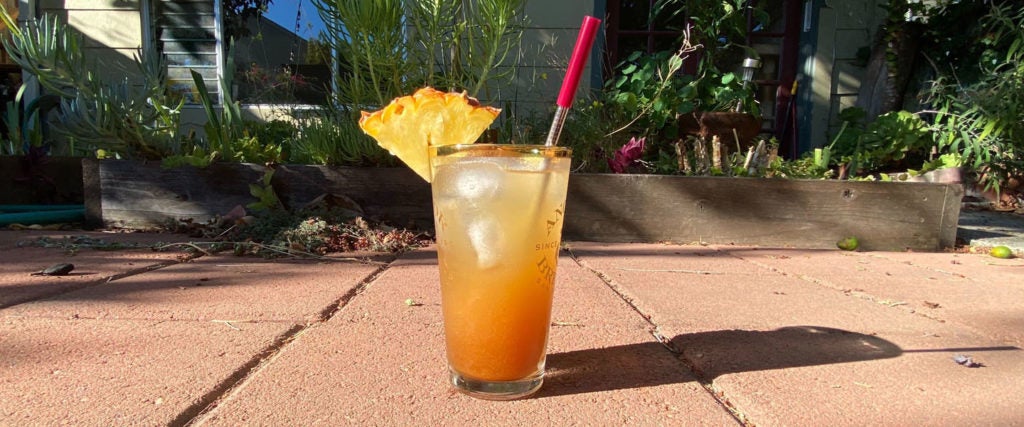The first time I tasted tepache, it was at Birrieria Jalisco in South Los Angeles, on a sweltering September day not long after the start of classes at the University of Southern California.
I had discovered an old Jonathan Gold review singing the praises of the Mexican goat stew known as “birria de chivo,” and cajoled my roommate Thomaz into trying something new. When we got there, two things were evident: Literally everyone was eating the same dish, and nearly every table had a icy glass of murky, brownish-yellow liquid on it. I had pored over every cut of goat you could order, but somehow missed the must-have beverage of the house.
“¿Que es eso?” I blurted to our approaching waitress, trying to be subtle while pointing a finger at a nearby glass.
“¡Tepache! Como una… like pineapple drink, but a little naturally sour,” she replied.
Pineapple drink, but citrusy?
I looked over at the brown glasses again. That didn’t sound right, but two tepaches it was. About 10 minutes later, we had our food, and I took a giant sip from my drink to kick off the meal. Then my brain ground to a halt. I could taste the pineapple, but it wasn’t sweet and tropical, but rather funky and full of savory notes. Syrupy brown-sugar sweetness, cinnamon and clove all hit my nose at once. While it wasn’t an alcoholic beverage, the tepache stank of malty, beer-like alcohol notes. The lightbulb went off: “Naturally sour” didn’t mean citrus. It meant fermentation.
Thomaz was just as surprised as I, and we giggled while sipping our pineapple drinks in that sweltering little birria joint, cracking jokes about how many we needed to catch an actual buzz. It felt like a symbolic drink for the transition of summer to fall — ripe, golden tropical fruit, aged until it falls apart and becomes a mahogany mash, with less sweetness and more earth in its flavor. And now, almost exactly a decade since I first tasted it, I’m craving the nostalgia of that very first tepache. Hell, I kind of feel like that metaphoric pineapple, having grown up in so many ways since.
Lucky for us, tepache is about as easy a fermented beverage as you can make at home. The toughest part of the recipe is finding a ripe pineapple that’s deep gold in color and fragrant. Mine was just shy of two pounds with the frilly top cut off, and you technically don’t even need whole pineapple — you can just use the peels, although I think the whole-fruit version tastes better.
Cut up the pineapple into rough chunks, and throw them into a large pitcher or jar. Add 2 quarts of water and either 1 cup of traditional unrefined piloncillo sugar (available at any Latin market) or brown sugar. It’s traditional to throw in a few sticks of cinnamon and a couple of whole cloves, and while I prefer this spice profile most, there’s room to experiment with things like star anise and black pepper.
What comes next? Just a vacation in a warm place, be it your kitchen counter or patio, with a thin towel or cheesecloth covering the container. The heat and sugar accelerate the fermentation process, and you’ll need to collect and discard the foam off the top of the tepache at about the 24-hour mark (12 hours if the tepache is sitting somewhere hot, rather than at room temp). Wait another 24 hours or so, and taste — it should be intense, gently tart and still quite fruity. Do beware: If you let the batch ferment for too long, it’ll turn into pineapple vinegar, which is delicious but not quite the goal. Also worth noting is that a lot of people dilute their tepache down, and I’m with this camp — it’s more refreshing when cut with ice water.
There is so much tradition and heritage to discover in the wide world of rustic Mexican fermentations; pineapple is actually a modern iteration, but I think it’s one of the best uses of the fruit, period. Odds are, you’ll find the flavor of tepache a little strange if you’re not used to other lightly fermented beverages, like kombucha. I wasn’t sure I liked it until I realized I couldn’t stop tasting another sip. There’s something wondrous about how organic materials can decompose into something not just edible, but better than it was. The murky sweetness of this drink captures that beauty in one easy-to-make recipe.
And if you need an actual buzz, not merely a light fermentation, it just so happens that tepache tastes killer with a shot of mezcal or tequila thrown in.

